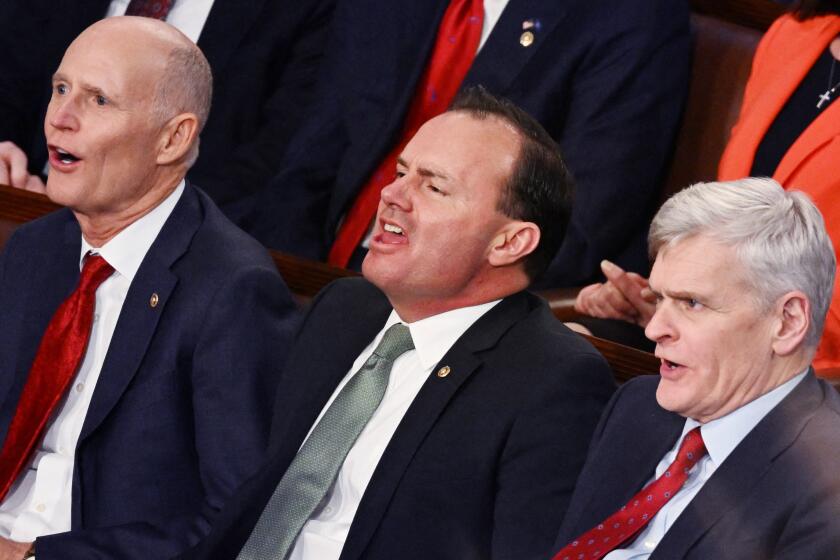Column: Social Security is perfectly healthy, but thereâs one easy way to improve it

âTis the season for hand-wringing over the fiscal condition of Social Security.
This annual event is invariably triggered by the release of the programâs trustees report, which occurred Friday. As is typical, the release inspired reams of journalistic and political alarmism about what will happen when the programâs reserves (that is, its two trust funds) are exhausted.
The trustees currently project that will happen in 2033. At that point, they say, current revenues from the payroll tax would be sufficient to cover 80% of currently scheduled benefits. Thatâs a year earlier than the projections in last yearâs trustees report.
A yearâs worth of fluctuation in the reserve depletion date is not a cause for alarm â or celebration, if it goes the other way!
— Kathleen Romig, Social Security expert at the Center on Budget and Policy Priorities
This sounded dire, superficially, and major news sources piled on. âSocial Security funding crisis will arrive in 2033, U.S. projects,â the Washington Post reported. The Committee for a Responsible Federal Budget, which is an offspring of the late private equity billionaire and Social Security foe Peter G. Peterson, declared in the wake of the trusteesâ report that âSocial Security is 11 years from insolvency.â
The annual report lent urgency to a raft of proposals to âfixâ Social Security. Most such proposals amount to benefit cuts; that would be the result of steps such as raising the retirement age, reducing payments to wealthier recipients, gutting cost-of-living increases and recalculating lifetime earnings.
Get the latest from Michael Hiltzik
Commentary on economics and more from a Pulitzer Prize winner.
You may occasionally receive promotional content from the Los Angeles Times.
Some even advocate starting to cut benefits now, supposedly because the resulting strain would be easier on retireesâ household budgets if itâs spread over a decade rather than coming all at once. This theme was hammered home by the CRFB , which asserted that âtime is running out to save Social Security.â Acting sooner rather than later, the committee said, âgives workers time to plan and adjust.â
So it behooves us to take a closer look at what the trustees actually said, at least so we have a better sense of the implications of any âreformâ proposals. Thatâs especially true because the would-be reformers generally skate over the one sure-fire method of providing all the revenues the system needs to fully cover its obligations: Raise the Social Security tax not on ordinary workers, but wealthier Americans who have been getting a free pass on their full obligations to the system.
First, letâs examine the implications of the one-year change in the year of projected trust fund exhaustion. As Kathleen Romig, the Social Security expert at the Center on Budget and Policy Priorities, pointed out on Twitter: âA yearâs worth of fluctuation in the reserve depletion date is not a cause for alarm â or celebration, if it goes the other way!â
For more than a decade, Romig observes, âevery Trusteesâ Report has estimated a reserve depletion date between 2033 and 2035.â Most of the change this year happened not because the programâs âfinances continue to deterioriate,â as the CRFB claims, but because of technical factors, Romig states.
These include a change in the programâs projection methodology and an update to its valuation period. The latter is the 75-year span over which the systemâs actuaries calculate its finances. Every year, that period advances by a year, so, a low-deficit year drops away and a high-deficit year is added. That increases the 75-year gap,â Romig writes, âeven if the shortfall in each individual year of the projection stays the same.â
The Wall Street Journal says America âsoaks the affluent.â Try to hold back your tears.
Big changes come from the systemâs estimates of inflation, productivity, birth rates and other demographic factors. The trustees are projecting higher inflation, lower production output and lower birth rates over the next decade and the 65 years beyond. But those estimates are based partially on snapshots of current conditions, so theyâre obviously conjectural.
The overwrought concerns about Social Securityâs fiscal condition never ceases to produce rococo proposals for reform. A persistent idea is to raise the retirement age. I deconstructed this plan in February, when the CRFB advanced it in the guise of promoting âproductive agingâ by removing âwork and savings disincentives in the current program.â (Translation from the CRFBâs gibberish: âMake working people work longer.â)
As I wrote then, proposals to raise the retirement age are based on the assumption that older workers would continue to work, perhaps until they drop dead, if not for what the CRFB called the âmixed retirement signals that often draw them into early retirement and treat retirement itself as a binary choice.â
That implies that workers are almost duped into filing for Social Security, when they would be so much happier staying on the job.
These proposals, however, never take into account the differences in life expectancies arising from ethnic, income and educational factors. Put simply, they would disproportionately penalize Black, lower-income and less-educated workers, as well as those whose working lives were spent in physically demanding jobs. These proposals boil down to rich desk-jockeys telling others to just suck it up.
Another perennial is to divert Social Security revenues into ostensibly more rewarding investments than the Treasury securities in which the program is legally bound to park its reserves. The trust funds, which hold those reserves, currently amount to more than $2.8 trillion.
The latest iteration of this idea is being formulated by a group of senators led by Bill Cassidy (R-La.) and Angus King (I-Maine).
Republicans say Biden is lying about their intention to cut Social Security and Medicare. The evidence backs him up.
Details of the Cassidy-King proposal are scanty, but whatâs known is that it would involve creating a âsovereign wealth fundâ of some $1.5 trillion in borrowed funds to invest in the stock market, real estate and other investments currently closed to the system.
The theory is that, over time, these investments would produce enough income to pay back the borrowings with interest and contribute whatâs left over to the Social Security reserve.
Fans of Social Securityâs investing in the stock market rely on the rule of thumb that over the long term the market yields an annual average of more than 8% over inflation. Over the last century, the return of the benchmark Standard & Poorâs 500 index was an annualized 7.51%, while the systemâs most recent purchases (in June 2022) were of Treasuries yielding an average 3%.
That makes the proposal seem simple. In the real world, itâs anything but. Itâs too easy to be fooled into âbelieving in the fantasy of a stock market âfree lunch,ââ observes the National Committee to Preserve Social Security and Medicare.
To begin with, as Iâve noted in the past, the actual yield of the stock market over periods of less than a century is highly variable. The inflation-adjusted compound annual growth rate of the S&P 500 for successive 45-year periods has ranged from 4.57% (in 1964-2008) to 8.27% (in 1975-2019).
Then there are the political implications of investing government funds in corporate equities. At a hearing in 1937, Sen. Arthur Vandenberg (R-Mich.) asked Arthur Altmeyer, a Social Security staff member and future commissioner, how he proposed to invest a reserve fund that was then expected to grow to $47 billion.
Raising the Social Security retirement age would hurt low-income and Black workers. Is that why Republicans love it?
âYou could invest it in U.S. Steel and some of the large corporations,â Altmeyer suggested.
âHe just threw up his hands in holy horror,â Altmeyer recalled years later. âThat would be socialism!â Vandenberg exclaimed.
In todayâs fraught political environment, the prospect is high that stock market investments would be monitored and questioned by congressional busybodies.
Are the investment managers applying âESGâ considerations to their choices? (Those are environmental, social and governance standards that some investment fiduciaries utilize to judge the prudence of investments.) Red-state politicians are so exercised over the very thought that this is happening that theyâve boycotted management firms that use them â at the potential cost of hundreds of millions of dollars in income.
The truth is that elaborate schemes to reach for yield are totally unnecessary, as almost all Social Security experts know. Whatâs needed to close the gap between current revenues and annual benefit payouts is simply to eliminate the cap on the payroll tax and apply it to investment income.
This year, the tax is capped at 12.4% of all wage income up to a maximum of $160,200, with the levy shared equally by employers and employees. Investment income such as capital gains and dividends are entirely exempted. Thatâs a little-appreciated dodge enjoyed by the 1%, who on average receive about half their annual income from those sources.
To see how this works, consider that the maximum payroll tax this year (counting both the employer and employee shares) is $19,864. For someone in the 1% collecting, say, $600,000 in wage income, that tax amounts not to 12.4% of income, but only 3.3%. If that $600,000 was only half the taxpayerâs income, with the rest coming from investments, his or her effective tax rate would be only 1.66%.
That points to the most effective means of shoring up Social Security. Removing the wage cap and adding a 6.2% tax on investment income would eliminate the entire projected revenue shortfall, according to the American Academy of Actuaries.
Indeed, those changes would provide enough headroom to accommodate a couple of long-overdue improvements, specifically raising the surviving spousal benefit to 75% of the deceased spouseâs benefit from the current 50%, and counting as covered earnings up to five years of childcare, which currently are counted as zero earnings.
Thereâs a reason why such an obvious solution gets short shrift from policymakers: It would hit the patrons of federal lawmakers where they live. Itâs much easier to pile the burdens of retirement funding onto middle- and low-income earners. They donât have the political megaphones of the affluent.
Whatâs most offensive about the reform proposals swirling around in Washington is that they assume that Americaâs working class can be easily gulled into thinking these solutions will be painless. Raise the retirement age over time â why, everyone is living longer, so whatâs wrong with that? Invest Social Security in the stock market? The riches will just flow in. Start cutting benefits now â who would really notice?
Letâs not overlook that the promoters of all these proposals promise that they would only affect young workers, not those nearing retirement or already on a pension. Whereâs the justice in that?
Thereâs only one rationale for any benefit cuts in Social Security. Itâs to build a wall around the wealth of the affluent by making everyone else pay. If youâre a member of the 99%, the âreformersâ are coming for you.
More to Read
Get the latest from Michael Hiltzik
Commentary on economics and more from a Pulitzer Prize winner.
You may occasionally receive promotional content from the Los Angeles Times.














